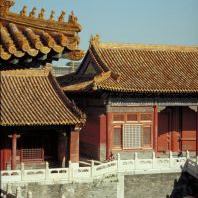 If you’re going to Beijing for the Olympics, you’ll want to see more of the city than the Games themselves.
If you’re going to Beijing for the Olympics, you’ll want to see more of the city than the Games themselves.
Beijing is home to dozens of fascinating attractions, and you won’t want to leave without seeing at least a few of them.
Here are just a handful of the most popular spots, so you’ll know where to go when you wander away from the sports arenas.
Tiananmen Square: Tiananmen means “gates of heavenly peace,” and today, it’s a somber and impressive place. The square, which is in the geographical center of town, is the largest in the world at roughly 109 acres. Most people think of the famous 1989 student protest when they think of Tiananmen Square, but it’s also the site of the daily Chinese flag ceremonies, which are worth observing. Mao’s tomb is here, as well as several museums, monuments, notable architecture, and landscaping.
 The Great Wall: No, you can’t really see it from space, but it’s much more impressive from the ground anyway. The classic tourist section is at Badaling, but it’s a long, long wall and there are plenty of sections you could visit. You can check out our Off the Brochure Travel Guide to Beijing for the more out-of-the-way sections worthy of a visit–and how you can get there.
The Great Wall: No, you can’t really see it from space, but it’s much more impressive from the ground anyway. The classic tourist section is at Badaling, but it’s a long, long wall and there are plenty of sections you could visit. You can check out our Off the Brochure Travel Guide to Beijing for the more out-of-the-way sections worthy of a visit–and how you can get there.
The Summer Palace: Built in the Jin Dynasty and once a summer retreat for emperors, this is one of the most celebrated gardens in China. The Empress Dowager Cixi, who lived there in the 1890s, embezzled some of the Navy’s money to renovate and add onto the palace. She even had a marble boat constructed, which of course was not very practical. The palace is full of halls, pagodas, pavilions, and winding paths around plant life and water, and if you have time, go and wander around the grounds.
 The Forbidden City: This is the largest and best-preserved Imperial Palace in the world. There are 8,000 rooms left of the original 9,999 that were built, and the complex is one of the five world-famous palaces. The Forbidden City has a moat and a wall around it. The reason for the security is simple: emperors and empresses of the Ming and Qing Dynasties lived here, so for more than 500 years (1368-1911), it was the governing center of China. The palace is well worth a look.
The Forbidden City: This is the largest and best-preserved Imperial Palace in the world. There are 8,000 rooms left of the original 9,999 that were built, and the complex is one of the five world-famous palaces. The Forbidden City has a moat and a wall around it. The reason for the security is simple: emperors and empresses of the Ming and Qing Dynasties lived here, so for more than 500 years (1368-1911), it was the governing center of China. The palace is well worth a look.
Temple of Heaven: This complex, which was built in 1420, is almost four times the size of the Forbidden City and is an amazing display of ancient Chinese culture. The emperors of China used to worship heaven here and pray for good crops. Two places in the Temple of Heaven are acoustically fascinating: one is the Echo Wall, where a whisper at one end of the wall can be heard clearly at the other end; the other is a spot on top of the three-level altar in which spoken words reverberate around the speaker. The entire complex is full of art and architecture and should not be missed.
The Place: This is a gigantic shopping center in the Central Business District. The main reason to go here (aside from the shopping) is the world’s second-largest LED screen. The screen hangs ABOVE the walkway and is 88 feet wide and the length of a city block. Look up as you shop, but don’t be surprised if the sight is overwhelming! It’s a stark spot of modernity in a city of ancient Chinese history.
By Erica Adams for PeterGreenberg.com.
Don’t miss other articles in our Beijing Olympics series…
GETTING THERE, GETTING AROUND:
- Beijing Olympics: Basic Tips for Your Travels
- An Olympic Guide to Overcoming the Hurdles Of Traveling to Beijing
- Bound for Beijing: A Guide to 2008 Olympic Travel
FOOD:
CULTURE AND FUN:












